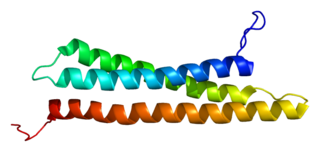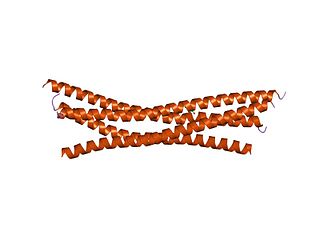
Synaptosomal-Associated Protein, 25kDa (SNAP-25) is a Target Soluble NSF (N-ethylmaleimide-sensitive factor) Attachment Protein Receptor (t-SNARE) protein encoded by the SNAP25 gene found on chromosome 20p12.2 in humans. SNAP-25 is a component of the trans-SNARE complex, which accounts for membrane fusion specificity and directly executes fusion by forming a tight complex that brings the synaptic vesicle and plasma membranes together.

Syntaxin-1A is a protein that in humans is encoded by the STX1A gene.

Synaptosomal-associated protein 23 is a protein that in humans is encoded by the SNAP23 gene. Two alternative transcript variants encoding different protein isoforms have been described for this gene.

Syntaxin-4 is a protein that in humans is encoded by the STX4 gene.

Synaptotagmin-1 is a protein that in humans is encoded by the SYT1 gene.

Vesicle-associated membrane protein 2 (VAMP2) is a protein that in humans is encoded by the VAMP2 gene.

Syntaxin-binding protein 1 is a protein that in humans is encoded by the STXBP1 gene. This gene encodes a syntaxin-binding protein. The encoded protein appears to play a role in release of neurotransmitters via regulation of syntaxin, a transmembrane attachment protein receptor. Mutations in this gene have been associated with neurological disorders including epilepsy, intellectual disability, and movement disorders.

Syntaxin-7 is a protein that in humans is encoded by the STX7 gene.

Syntaxin-6 is a protein that in humans is encoded by the STX6 gene.

Vesicle-associated membrane protein 3 is a protein that in humans is encoded by the VAMP3 gene.

Syntaxin-5 is a protein that in humans is encoded by the STX5 gene.

Syntaxin-12 is a protein that in humans is encoded by the STX12 gene.

Syntaxin-8 is a protein that in humans is encoded by the STX8 gene.

Golgi SNAP receptor complex member 1 is a protein that in humans is encoded by the GOSR1 gene.

Syntaxin-binding protein 2 is a protein that in humans is encoded by the STXBP2 gene.

Syntaxin-binding protein 3 is a protein that in humans is encoded by the STXBP3 gene.

Vesicle-associated membrane protein 1 (VAMP1) is a protein that in humans is encoded by the VAMP1 gene.

Syntaxin-1B is a protein that in humans is encoded by the STX1B gene.

Syntaxin 3, also known as STX3, is a protein which in humans is encoded by the STX3 gene.
Munc-18 proteins are the mammalian homologue of UNC-18 and are a member of the Sec1/Munc18-like (SM) protein family. Munc-18 proteins have been identified as essential components of the synaptic vesicle fusion protein complex and are crucial for the regulated exocytosis of neurons and neuroendocrine cells.




















